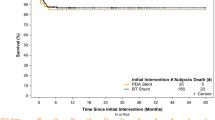Abstract
Congenital heart disease contributes significantly to the health burden of children in Nigeria. Interventions for congenital heart disease have been available in the developed world since the first report on device closure of patent ductus arteriosus (PDA) in 1967 by Porstmann. However, this did not start in Nigeria until October 2010. This study aimed to document the profiles of the patients who had undergone interventions for congenital heart diseases since the availability of the procedure, the challenges encountered, and the prospects associated with the interventions at the study site. All the patients referred to undergo interventions for congenital heart disease at the study center between October 2010 and 2012 were studied. The profile of the patient, including diagnosis at referral, indication for interventions, and interventions performed, were documented. The patients ranged in age from 3 to 62 years (mean age, 13.54 ± 17.7 years), and the male-to-female ratio was 1:3. The diagnosis at referral included PDA in 10 (83 %) of the 12 patients and secundum atrial septal defect in 2 patients (17 %). They all had transcatheter closure of the defects. Interventional procedures for congenital heart diseases currently are available locally, but the high degree of manpower training required, the cost, and the local availability of consumables are major factors limiting their use. Regional and international collaboration could be mutually beneficial.
Similar content being viewed by others
References
AMPLATZER Duct Occluder Patient Guide by AGA medical corporation MM00318 (02) Global 04/08
Animasahun BA, Johnson A, Ogunkunle OO, Idowu S, Bode-Thoma F, Maheshwari S, Njokanma OF, Omokhodion SI (2012) Transcatheter closure of patent ductus arteriosus: report of the first case in Nigeria. Afr J Med Med Sci 3:41–44
Antia AU (1974) Congenital heart disease in Nigeria. Arch Dis Child 49:36–39
Austin EH (2003) Transcatheter closure of atrial septal defects. J Thorac Cardiovasc Surg 125:85–86
Bov Th, Franois K, De groote Suys KB, De Wolf D, Nooten GV (2005) Closure of atrial septal defects: is there still a place for surgery? Acta Chir Belg 105:497–503
Cambier PA, Kirby WC, Wortham DC, Moore JW (1992) Percutaneous closure of the small (less than 2.5 mm) patent ductus arteriosus using coil embolization. Am J Cardiol 69:815–816
Chen ZY, Wu LM, Luo YK et al (2009) Comparison of long-term clinical outcome between transcatheter Amplatzer occlusion and surgical closure of isolated patent ductus arteriosus. Chin Med J Engl 122:1123–1127
Fyler DC (1992) Atrial septal defect secundum. In: Fyler DC (ed) Nadas’ Pediatric cardiology. Hanley & Belfus, Philadelphia, pp 513–524
King TD, Mills NL (1976) Secundum atrial septal defects: nonoperative closure during cardiac catheterization. J Am Med Assoc 235:2506–2509
Laborde F, Folliguet TA, Etienne PY et al (1997) Video-thoracoscopic surgical interruption of patent ductus arteriosus: routine experience in 332 pediatric cases. Eur J Cardiothorac Surg 11:1052–1105
Latson LA, Benson LN, Hellenbrand WE, Mulins CE, Lock JE (1991) Transcatheter closure of ASD: early results of multicenter trial of the Bard clamshell septal occluder. Circulation 84:44
Michael M, Brook MD, Michael M, Heyman MD (1995) Patent ductus arteriosus. In: Moss Adams heart disease in infants, children, and adolescents. 5th edn. William and Wilkins, Baltimore, pp 746–764
Okoromah CAN, Ekure EN, OJo OO, Animasahun BA, Bastos MI (2008) Structural heart disease in children in Lagos: profile, problems, and prospects. Nigerian Postgrad Med J 15:31–82
Oyedeji GA (1985) Socioeconomic and cultural background of hospitalized children in Ilesha. Nig J Paediatr 12:111–117
Pass RH, Hijazi Z, Hsu DT et al (2004) Multicenter USA Amplatzer patent ductus arteriosus occlusion device trial: initial and one-year results. J Am Coll Cardiol 44:513–519
Porstmann W, Wierny L, Warnke H (1967) Closure of the patent ductus arteriosus without thoracotomy. Ger Med Mon 12:259–261
Raghuram AR, Krishnan R, Kumar S, Balamurugan K (2008) Complications in atrial septal defect device closure. Interact Cardiovasc Thorac Surg 7:167–169
Reza AQM, Siddique AB, Talukder MSU, Munwar S, Islam AHMW, Sholel SR, Ghani MA (2010) Transcatheter technique now standard for secundum ASD closure: a case report of our first experience. Case Rep 4:32–33
Sam’anek M (1992) Children with congenital heart disease: probability of natural survival. Pediatr Cardiol 13:152–158
Sato K, Fujino M, Kozuka T, Naito Y, Kitamura S, Nakano S, Ohyama C, Kawashima Y (1975) Transfemoral plug closure of patent ductus arteriosus: experiences in 61 consecutive cases treated without thoracotomy. Circulation 51:337–341
Vanamo K, Berg E, Kokki H et al (2006) Video-assisted thoracoscopic versus open surgery for persistent ductus arteriosus. J Pediatr Surg 41:1226–1229
Author information
Authors and Affiliations
Corresponding author
Rights and permissions
About this article
Cite this article
Animasahun, B.A., Johnson, A., Ogunkunle, O.O. et al. Transcatheter Closure of Patent Ductus Arteriosus and Atrial Septal Defect Without On-Site Surgical Backup: A Two-Year Experience in an African Community. Pediatr Cardiol 35, 149–154 (2014). https://doi.org/10.1007/s00246-013-0753-x
Received:
Accepted:
Published:
Issue Date:
DOI: https://doi.org/10.1007/s00246-013-0753-x




